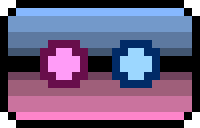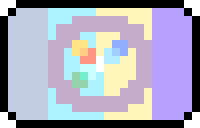
Gonadal Dysgenesis

Table of Contents
- General Information
- Complete Gonadal Dysgenesis/Pure Gonadal Dysgenesis/Swyer Syndrome
- Partial Gonadal Dysgenesis/PGD
- Mixed Gonadal Dysgenesis/MGD
- External Links

General Information
This is a group of different variations that affect the development of the gonads before birth.

Gonadal Dysgenesis Flag


Complete Gonadal Dysgenesis/Pure Gonadal Dysgenesis/Swyer Syndrome
The body of a preson with complete gonadal dysgensis has either XX or XY chromosomes and fiberous gonadal tissue that has not developed into testicles or ovaries (known as streak gonads). A person with complete gonadal dysgensis is generally born with a vulva and a vagina. They will usually not develop secondary sex characteristics at puberty, as streak gonads do not produce hormones.
Swyer syndrome occurs when someone is born with XY chromosomes, but their gonads have not developed into testes. Since the streak gonads do not produce testosterone, the body does not develop a penis, and instead usually develops a vagina and vulva. As they do not produce another hormone known as anti-Müllerian hormone (AMH), they often develop a uterus and fallopian tubes as well. People with Swyer Syndrome usually do not start puberty nor menstruate, though with estrogen therapy, they will menstruate without ovulation.

Partial Gonadal Dysgenesis/PGD
A person with PGD inherently has 46/XY without mosaicism. and may develop some testicular tissue and some gonadal streak tissue. They may be born with a penis, a vulva, or with visible genital variations. They usually have a partially or completely developed uterus, and may have combinations of internal reproductive structures, such as a vas deferens and a fallopian tube on opposite sides of the body. They may develop some secondary sex characteristics associated with a typical testosterone-based puberty, depending on the amount of hormone-producing testicular tissue present.

Mixed Gonadal Dysgenesis/MGD
Someone with mgd inherently has some layout of XO/XY (or XX/XY, XO/XXY, XX/XXY, etc) and may develop some testicular tissue and some gonadal streak tissue. They may be born with a penis, a vulva, or with visible genital variations. They usually have a partially or completely developed uterus, and may have combinations of internal reproductive structures, such as a vas deferens and a fallopian tube on opposite sides of the body. They may develop some secondary sex characteristics associated with a typical testosterone-based puberty, depending on the amount of hormone-producing testicular tissue present.

Mixed Gonadal Dysgenesis Flag


External Links
The resources below have been provided for education, information sourcing, and entertainment purposes. The views expressed in these videos, websites, etc, do not inherently reflect those of The Transgender Dictionary. These resources are not sponsored, nor endorsed.

Additional Resources
- Intersex Wiki - Gonadal Dysgenesis (https://intersex.wiki/wiki/Gonadal_dysgenesis)
- itch.io - 404luxio - tiny pixel pride flags (https://404luxio.itch.io/tiny-pixel-pride-flags) - link to flag used on this page
- Tumblr: gonyadaldysgenesis: 06/14/2025: mixed gonadal dysgenesis flag (https://www.tumblr.com/the-transgenda-agenda/790792979009961985)

